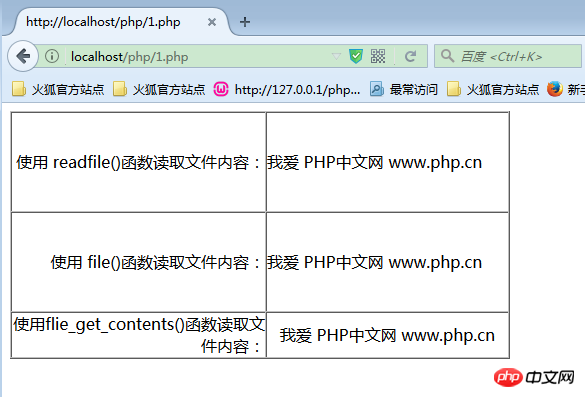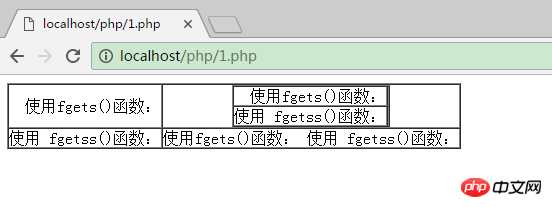PHP file handling - how to read a file (one line, whole file)
PHP file processing—how to read a file (one line, the entire file)
Reading and writing files is more complicated than opening and closing files. Here we mainly explain from two aspects: reading data and writing data.
Then in the previous article "PHP File Processing - Opening and Closing Files", opening and closing files was introduced. Opening files is the prerequisite for all file operations, and closing is the prerequisite for all operations. The end of the file, then today we will introduce how to read the file!
Read data from the file
Read data from the file, you can read a character, a line of string or the entire file , you can also read a string of specified length.
1. Read the entire file: readfile(), flie() and file_get_contents() three functions, we will introduce them one by one below!
readfile() function
The readfile() function is used to read a file and write it to the output buffer. If an error occurs, it returns false. The function syntax format is as follows:
int readfile ( string $filename [, bool $use_include_path = false [, resource $context ]] )
Using the readfile() function, there is no need to open and close the file, and there is no need for echo, print and other output statements. Just write the file path first.
flie() function
flie() function can also read the contents of the entire file, but the file() function stores the file contents into an array line by line. Including newlines, returns false if the read fails. The syntax format of the function is as follows:
array file ( string $filename [, int $flags = 0 [, resource $context ]] )
file_get_contents() function
file_get_contents() function reads the contents of the file (fliename) into a string. If there are no offset and maxlen parameters, a string of length maxlen will be read starting from the position specified by the offset parameter. If the read fails, false will be returned. The function syntax format is as follows;
string file_get_contents ( string $filename [, bool $use_include_path = false [, resource $context [, int $offset = -1 [, int $maxlen ]]]] )
This function is suitable for binary files and is the preferred method to read the entire file content into a string.
The following example uses the above three functions to read the file content separately. The specific code is as follows:
<html>
<body>
<table width="500" border="1" cellpadding="0" cellspacing="0" >
<tr>
<td width="253" height="100" align="right" valign="middle" scope="col">使用 readfile()函数读取文件内容:</td>
<td width="241" height="100" valign="middle" scope="col">
<!--使用 readfile()函数读取tm.txt文件内容-->
<?php readfile("tm.txt");?></td>
</tr>
<tr>
<td height="100" align="right" valign="middle">使用 file()函数读取文件内容:</td>
<td height="100" valign="middle" >
<!--使用 file()函数读取tm.txt文件内容-->
<?php
$f_arr = file("tm.txt");
foreach ($f_arr as $cont){
echo $cont."<br>";
}
?>
</td>
</tr>
<tr>
<td width="250" height="25" align="right" valign="middle" scope="col">使用flie_get_contents()函数读取文件内容:</td>
<td height="25" valign="middle" align="center" scope="col" >
<!--使用 flie_get_contents()函数读取tm.txt文件内容-->
<?php
$f_chr = file_get_contents("tm.txt");
echo $f_chr;
?>
</td>
</tr>
</table>
</body>
</html>The output result is:

2. Read a row of data: fgets() function and fgetss() function
(1) fgets() function
fgets() function is used to read one row of data at a time. The function syntax is as follows:
string fgets ( resource $handle [, int $length ] )
The parameter handle is the file to be read, and the parameter length is the length of the data to be read. The function can read a line from the file specified by handle and return a string with a maximum length of length-1 bytes. Stops with newline character, EOF or after reading length-1 times. If the length-1 parameter is omitted, data is read until the end of the line.
(2)fgetss() function
The fgetss() function is a variant of the fgets() function and is used to read a row of data. At the same time, the fgetss() function will filter out HTML and PHP tags in the content being read. The function syntax is as follows:
string fgetss ( resource $handle [, int $length [, string $allowable_tags ]] )
This function can filter out any html and PHP tags from the read file. You can use the allowable_tags parameter to control which tags are not filtered out.
The following example uses the above function to read a file respectively and display it. Observe the difference between them. The specific code is as follows:
<html>
<body>
<table border="1" cellpadding="0" cellspacing="0" >
<tr>
<td align="right" valign="middle" scope="col">使用fgets()函数:</td>
<td valign="middle" scope="col" align="center">
<!--使用fgets()函数读取fun.php文件-->
<?php
$fopen = fopen("1.php","rb");
while (!feof($fopen)){
echo fgets($fopen);
}
fclose($fopen);
?></td>
</tr>
<tr>
<td align="right" valign="middle">使用 fgetss()函数:</td>
<td align="center" valign="middle" >
<!--使用fgetss()函数读取-->
<?php
$fopen = fopen("1.php","rb");
while (!feof($fopen)){
echo fgetss($fopen);
}
fclose($fopen);
?></td>
</tr>
</table>
</body>
</html>The output result is:

This article introduces two methods of reading files, one is to read the entire file, and the other is It reads one line of data. In the next article, I will introduce reading one character and a string of specified length. For details, please read "PHP File Processing—Reading File (One Character, String)》!
The above is the detailed content of PHP file handling - how to read a file (one line, whole file). For more information, please follow other related articles on the PHP Chinese website!

Hot AI Tools

Undresser.AI Undress
AI-powered app for creating realistic nude photos

AI Clothes Remover
Online AI tool for removing clothes from photos.

Undress AI Tool
Undress images for free

Clothoff.io
AI clothes remover

Video Face Swap
Swap faces in any video effortlessly with our completely free AI face swap tool!

Hot Article

Hot Tools

Notepad++7.3.1
Easy-to-use and free code editor

SublimeText3 Chinese version
Chinese version, very easy to use

Zend Studio 13.0.1
Powerful PHP integrated development environment

Dreamweaver CS6
Visual web development tools

SublimeText3 Mac version
God-level code editing software (SublimeText3)

Hot Topics
 Explain JSON Web Tokens (JWT) and their use case in PHP APIs.
Apr 05, 2025 am 12:04 AM
Explain JSON Web Tokens (JWT) and their use case in PHP APIs.
Apr 05, 2025 am 12:04 AM
JWT is an open standard based on JSON, used to securely transmit information between parties, mainly for identity authentication and information exchange. 1. JWT consists of three parts: Header, Payload and Signature. 2. The working principle of JWT includes three steps: generating JWT, verifying JWT and parsing Payload. 3. When using JWT for authentication in PHP, JWT can be generated and verified, and user role and permission information can be included in advanced usage. 4. Common errors include signature verification failure, token expiration, and payload oversized. Debugging skills include using debugging tools and logging. 5. Performance optimization and best practices include using appropriate signature algorithms, setting validity periods reasonably,
 How do you parse and process HTML/XML in PHP?
Feb 07, 2025 am 11:57 AM
How do you parse and process HTML/XML in PHP?
Feb 07, 2025 am 11:57 AM
This tutorial demonstrates how to efficiently process XML documents using PHP. XML (eXtensible Markup Language) is a versatile text-based markup language designed for both human readability and machine parsing. It's commonly used for data storage an
 Explain late static binding in PHP (static::).
Apr 03, 2025 am 12:04 AM
Explain late static binding in PHP (static::).
Apr 03, 2025 am 12:04 AM
Static binding (static::) implements late static binding (LSB) in PHP, allowing calling classes to be referenced in static contexts rather than defining classes. 1) The parsing process is performed at runtime, 2) Look up the call class in the inheritance relationship, 3) It may bring performance overhead.
 PHP Program to Count Vowels in a String
Feb 07, 2025 pm 12:12 PM
PHP Program to Count Vowels in a String
Feb 07, 2025 pm 12:12 PM
A string is a sequence of characters, including letters, numbers, and symbols. This tutorial will learn how to calculate the number of vowels in a given string in PHP using different methods. The vowels in English are a, e, i, o, u, and they can be uppercase or lowercase. What is a vowel? Vowels are alphabetic characters that represent a specific pronunciation. There are five vowels in English, including uppercase and lowercase: a, e, i, o, u Example 1 Input: String = "Tutorialspoint" Output: 6 explain The vowels in the string "Tutorialspoint" are u, o, i, a, o, i. There are 6 yuan in total
 What are PHP magic methods (__construct, __destruct, __call, __get, __set, etc.) and provide use cases?
Apr 03, 2025 am 12:03 AM
What are PHP magic methods (__construct, __destruct, __call, __get, __set, etc.) and provide use cases?
Apr 03, 2025 am 12:03 AM
What are the magic methods of PHP? PHP's magic methods include: 1.\_\_construct, used to initialize objects; 2.\_\_destruct, used to clean up resources; 3.\_\_call, handle non-existent method calls; 4.\_\_get, implement dynamic attribute access; 5.\_\_set, implement dynamic attribute settings. These methods are automatically called in certain situations, improving code flexibility and efficiency.
 PHP and Python: Comparing Two Popular Programming Languages
Apr 14, 2025 am 12:13 AM
PHP and Python: Comparing Two Popular Programming Languages
Apr 14, 2025 am 12:13 AM
PHP and Python each have their own advantages, and choose according to project requirements. 1.PHP is suitable for web development, especially for rapid development and maintenance of websites. 2. Python is suitable for data science, machine learning and artificial intelligence, with concise syntax and suitable for beginners.
 PHP: A Key Language for Web Development
Apr 13, 2025 am 12:08 AM
PHP: A Key Language for Web Development
Apr 13, 2025 am 12:08 AM
PHP is a scripting language widely used on the server side, especially suitable for web development. 1.PHP can embed HTML, process HTTP requests and responses, and supports a variety of databases. 2.PHP is used to generate dynamic web content, process form data, access databases, etc., with strong community support and open source resources. 3. PHP is an interpreted language, and the execution process includes lexical analysis, grammatical analysis, compilation and execution. 4.PHP can be combined with MySQL for advanced applications such as user registration systems. 5. When debugging PHP, you can use functions such as error_reporting() and var_dump(). 6. Optimize PHP code to use caching mechanisms, optimize database queries and use built-in functions. 7
 PHP in Action: Real-World Examples and Applications
Apr 14, 2025 am 12:19 AM
PHP in Action: Real-World Examples and Applications
Apr 14, 2025 am 12:19 AM
PHP is widely used in e-commerce, content management systems and API development. 1) E-commerce: used for shopping cart function and payment processing. 2) Content management system: used for dynamic content generation and user management. 3) API development: used for RESTful API development and API security. Through performance optimization and best practices, the efficiency and maintainability of PHP applications are improved.






